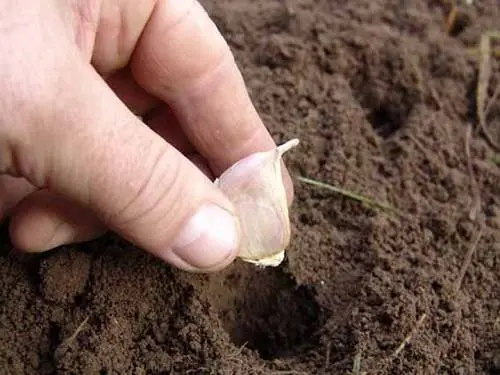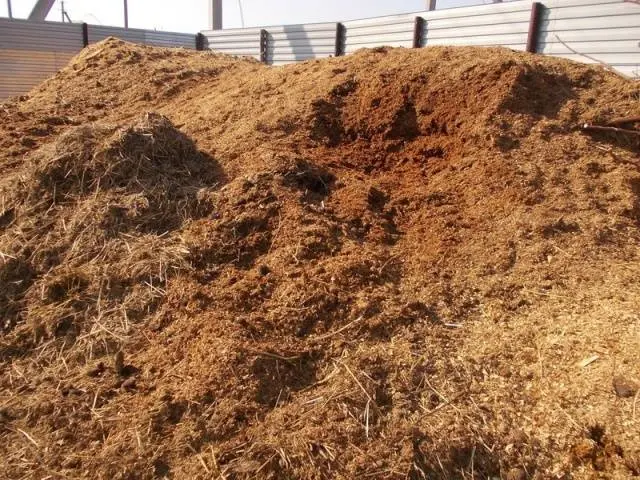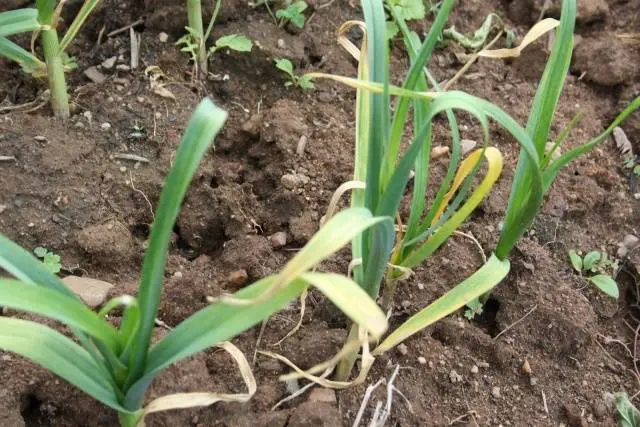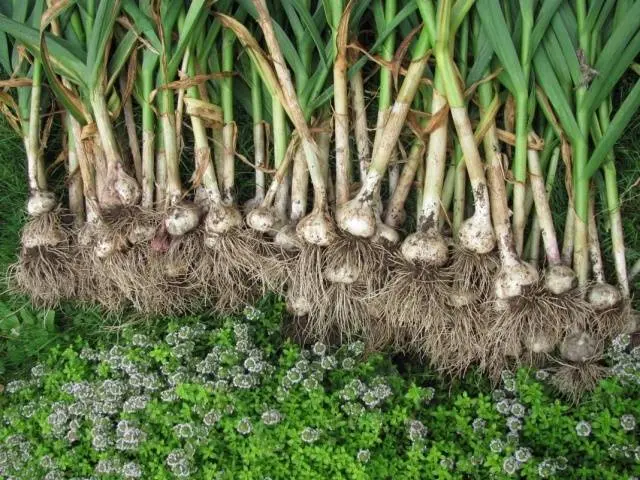Contents
Garlic is an undemanding crop that can grow in any soil. But in order to get a truly magnificent harvest, you need to know the rules for growing garlic, using fertilizers and applying them to your beds.

Preparation of beds
The rules for preparing garlic beds and fertilizing them are the same for both winter and spring planting of garlic.
For planting garlic, it is necessary to choose a bright area, with fertile soil, in partial shade it develops slowly, often gets sick. The plant does not tolerate stagnant water, so it is necessary to build a good drainage system.
Garlic grows best in light, nutritious sandy soils with neutral acidity. If the characteristics of the soil in the garden are far from ideal, you can try to improve the performance in order to get a good harvest.

Heavy clay soils slow down the development of garlic, it grows later than the deadline, the cloves are small. Most of all, winter garlic suffers from such soil, clay soils often do not conduct water and air well, cloves quickly rot in conditions of high humidity and low temperatures.
You can improve the soil structure on garlic beds with the help of the following additives, they can be combined or applied separately:
- Sand;
- Sawdust;
- Humus;
- Peat;
- Overripe manure.
Sand is added during the digging of the soil, most often in the fall. 1-2 buckets of sand are added per square meter of soil, you can use river or quarry sand. The sand is evenly scattered over the garlic bed, after which the soil is dug up.

To improve the structure of the soil, sawdust can be added, any, except for oak, will do, as they contain substances that can inhibit the root system of plants. It is advisable to use well-rotted sawdust, as a rule, they are dark brown or black. Fresh sawdust during decay in the soil uses a lot of nitrogen, the plant will be deficient in this substance.
Humus and peat will perfectly improve the soil on garlic beds, in addition, they will enrich it with nutrients, they can be used as nitrogen fertilizers. 2 buckets of humus or peat are evenly scattered on a square meter of garlic beds, after which the soil is dug up by 20–25 cm.
Manure on garlic beds must be applied carefully, excess content can damage the garlic crop. In small doses it will be a good fertilizer. Poorly rotted manure can be a source of fungal spores that can cause fungal diseases in the plant and infect the soil in the garden. It is advisable to treat the manure with fungicides before applying it to the soil. No more than half a bucket of manure is brought per square meter of beds.
In this case, the recommended dosage of ready-made fertilizers is halved.

The high acidity of the soil does not allow the root system to fully absorb nutrients from fertilizers, the plant develops very poorly, the harvest will be poor. To avoid this, during the preparation of garlic beds, along with fertilizers, substances are introduced that can reduce the acidity of the soil. You can use dolomite flour, lime.
Before digging garlic beds, it is advisable to apply complex fertilizer in order to avoid a deficiency of trace elements in the soil. Fertilizer must necessarily contain potassium, phosphorus, boron, calcium and nitrogen. The recommended doses of fertilizers are indicated in the instructions for the preparation.
A complex fertilizer for garlic when planting is chosen, focusing on the reputation of the manufacturer and your own preferences. You can not buy garlic fertilizers in random places, storage errors can significantly degrade the performance of the product.
Planting material processing
Before planting, the head of garlic is disassembled, large, dense, without spots and mechanical damage, cloves are selected. The softness of the teeth may be a sign of a bacterial or fungal disease, they will not give a good harvest.
Varieties recommended for planting in spring may freeze even under cover. Preference is given to zoned varieties of garlic.
Selected garlic can be soaked for several hours in a solution of fertilizers and stimulants, this will help increase the supply of nutrients in the teeth, therefore, the seedlings will be stronger, with good immunity. Fertilizers should include increased doses of potassium and magnesium, which help accelerate photosynthesis, respectively, shoots will appear earlier.
To soak 1 kg of garlic cloves, you need a tablespoon of honey.

In addition to fertilizer treatment, it is advisable to use disinfectants before planting garlic. When planting, cloves can be injured, treatment can help avoid infection with fungal and other diseases.
Fertilizers during growth
The first fertilizing is carried out when he has 3-4 feathers. This is a time of intensive growth, the most important trace elements are nitrogen and phosphorus, which contribute to the development of the root system and green mass. For winter garlic, it is necessary to apply magnesium fertilizers, they will help it to winter better.
The second feeding is carried out two weeks after the first. Nitrogen fertilizers are not applied this time, it is necessary to choose fertilizers that contain phosphorus, potassium and boron. You can use watering with fertilizers under the root, or spraying the green parts of the plant. Spraying with a solution of fertilizers is carried out in dry, calm weather, in the early morning.
The third fertilization is carried out three weeks after the second. This time it is necessary to add: nitrogen, potassium, boron, magnesium, phosphorus and other trace elements. You can use ready-made complex fertilizers for garlic, all the components in them are in the correct proportion.
Further fertilization is carried out if necessary, focusing on the appearance of garlic. If there are no signs of nutrient deficiencies, you can stop fertilizing.
For these purposes, you can use wood ash. To speed up the absorption of a chemical element, a solution is used; 2 liters of water will require 5 tablespoons of wood ash.

Signs of a micronutrient deficiency
The lack of trace elements can be determined by the appearance of the plant.
Nitrogen
This chemical element promotes the growth of garlic.
If there is not enough nitrogen in the soil, the growth of the plant stops, the formation of the bulb stops. Garlic completes the growing season ahead of time, the heads of garlic are very small.
Outwardly, a lack of nitrogen can be seen by a change in the color of the leaves – they lose their color intensity, noticeably lag behind in growth.
potassium
Affects the keeping quality of garlic.
Potassium deficiency delays the growth of garlic, reduces resistance to drought and other adverse factors. Leaves with a deficiency of potassium brighten, starting with the veins, gradually the spots spread to the entire leaf. The tips of the garlic dry out, the entire leaf begins to dry gradually.
Phosphorus
Promotes the formation of the bulb, the development of the root system, improving the ability to resist adverse factors.
Lack of phosphorus causes a stop in the development of the root system, garlic stops growing. Deficiency can be seen by dark green leaves, sometimes with a bronze tint, garlic roots are small, underdeveloped.
Magnesium
Promotes metabolism in garlic, growth and immunity. The lack of this trace element reduces the ability of the plant to winter, slows down the development and formation of teeth.
The deficiency is characterized by reddish leaves, the veins may remain green. Starts from the bottom leaves.
Bor
Participates in all growth processes, promotes the formation of seeds.
Deficiency is expressed in chlorosis of young leaves, which are closer to the middle of the plant. Later, the edges and tops of the leaves dry out.

Conclusion
The rules for growing garlic are simple, careful use of fertilizers and following the recommendations will help grow a rich harvest of garlic, regardless of the vagaries of the weather.









